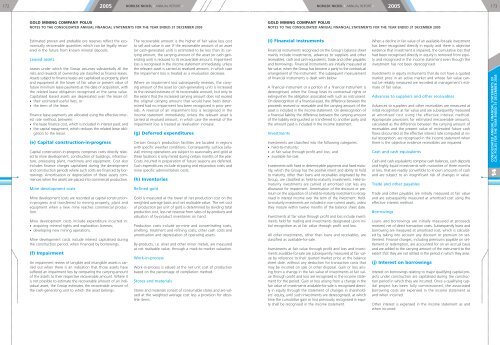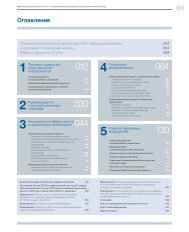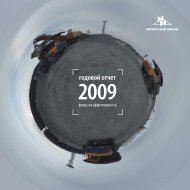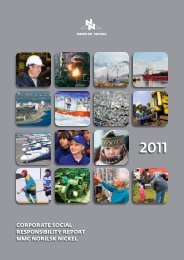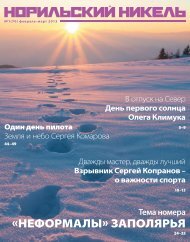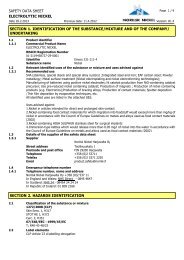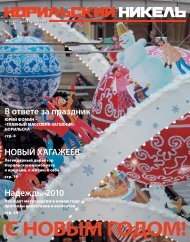Untitled - PRIME Gold
Untitled - PRIME Gold
Untitled - PRIME Gold
- No tags were found...
You also want an ePaper? Increase the reach of your titles
YUMPU automatically turns print PDFs into web optimized ePapers that Google loves.
1722005NORILSK NICKEL • ANNUAL REPORT •NORILSK NICKEL • ANNUAL REPORT •2005173GOLD MINING COMPANY POLUSNOTES TO THE CONSOLIDATED ANNUAL FINANCIAL STATEMENTS FOR THE YEAR ENDED 31 DECEMBER 2005GOLD MINING COMPANY POLUSNOTES TO THE CONSOLIDATED ANNUAL FINANCIAL STATEMENTS FOR THE YEAR ENDED 31 DECEMBER 2005Estimated proven and probable ore reserves reflect the economicallyrecoverable quantities which can be legally recoveredin the future from known mineral deposits.Leased assetsLeases under which the Group assumes substantially all therisks and rewards of ownership are classified as finance leases.Assets subject to finance leases are capitalised as property, plantand equipment at the lower of fair value or present value offuture minimum lease payments at the date of acquisition, withthe related lease obligation recognised at the same value.Capitalised leased assets are depreciated over the lesser of:• their estimated useful lives, or• the term of the lease.Finance lease payments are allocated using the effective interestrate method, between:• the lease finance cost, which is included in interest paid; and• the capital repayment, which reduces the related lease obligationto the lessor.(e) Capital construction-in-progressCapital construction-in-progress comprises costs directly relatedto mine development, construction of buildings, infrastructure,processing plant, machinery and equipment. Cost alsoincludes finance charges capitalised during the developmentand construction periods where such costs are financed by borrowings.Amortisation or depreciation of these assets commenceswhen the assets are placed into commercial production.Mine development costsMine development costs are recorded as capital constructionin-progressand transferred to mining property, plant andequipment when a new mine reaches commercial production.Mine development costs include expenditure incurred in:• acquiring mineral rights and exploration licenses;• developing new mining operations.Mine development costs include interest capitalised duringthe construction period, when financed by borrowings.(f) ImpairmentAn impairment review of tangible and intangible assets is carriedout when there is an indication that those assets havesuffered an impairment loss by comparing the carrying amountof the assets to their respective recoverable amount. Where itis not possible to estimate the recoverable amount of an individualasset, the Group estimates the recoverable amount ofthe cash-generating unit to which the asset belongs.The recoverable amount is the higher of fair value less costto sell and value in use. If the recoverable amount of an asset(or cash-generated unit) is estimated to be less than its carryingamount, the carrying amount of the asset (or cash generatingunit) is reduced to its recoverable amount. Impairmentloss is recognised in the income statement immediately, unlessthe relevant asset is carried at revalued amount, in which casethe impairment loss is treated as a revaluation decrease.Where an impairment loss subsequently reverses, the carryingamount of the asset (or cash-generating unit) is increasedto the revised estimate of its recoverable amount, but only tothe extent that the increased carrying amount does not exceedthe original carrying amount that would have been determinedhad no impairment loss been recognized in prior periods.A reversal of an impairment loss is recognised in theincome statement immediately, unless the relevant asset iscarried at revalued amount, in which case the reversal of theimpairment loss is treated as revaluation increase.(g) Deferred expendituresCertain Group's production facilities are located in regionswith specific weather conditions. Consequently, surface (alluvial)mining operations are subject to seasonality and gold atthese locations is only mined during certain months of the year.Costs incurred in preparation of future seasons are deferred.Such expenditures include stripping and excavation costs andmine specific administration costs.(h) InventoriesRefined gold<strong>Gold</strong> is measured at the lower of net production cost on theweighted average basis and net realisable value. The net costof production per unit of gold is determined by dividing totalproduction cost, less net revenue from sales of by-products andvaluation of by-product inventories on hand.Production costs include on-mine and concentrating costs,smelting, treatment and refining costs, other cash costs andamortisation and depreciation of operating assets.By-products, i.e. silver and other minor metals, are measuredat net realisable value, through a mark-to-market valuation.Work-in-processWork-in-process is valued at the net unit cost of productionbased on the percentage of completion method.Stores and materialsStores and materials consist of consumable stores and are valuedat the weighted average cost less a provision for obsoleteitems.(i) Financial instrumentsFinancial instruments recognised on the Group's balance sheetmainly include investments, advances to suppliers and otherreceivables, cash and cash equivalents, trade and other payablesand borrowings. Financial instruments are initially measured atfair value, when the Group has become a party to the contractualarrangement of the instrument. The subsequent measurementof financial instruments is dealt with below.A financial instrument or a portion of a financial instrument isderecognised, when the Group loses its contractual rights orextinguishes the obligation associated with such an instrument.On derecognition of a financial asset, the difference between theproceeds received or receivable and the carrying amount of theasset is included in the income statement. On derecognition ofa financial liability the difference between the carrying amountof the liability extinguished or transferred to another party andthe amount paid is included in the income statement.InvestmentsInvestments are classified into the following categories:• held-to-maturity;• at fair value through profit and loss; and• available-for-sale.Investments with fixed or determinable payments and fixed maturity,which the Group has the positive intent and ability to holdto maturity, other than loans and receivables originated by theGroup, are classified as held-to-maturity investments. Held-tomaturityinvestments are carried at amortised cost less anyallowance for impairment. Amortisation of the discount or premiumon the acquisition of a held-to-maturity investment is recognisedin interest income over the term of the investment. Heldto-maturityinvestments are included in non-current assets, unlessthey mature within twelve months of the balance sheet date.Investments at fair value through profit and loss include investmentsheld for trading and investments designated upon initialrecognition as at fair value through profit and loss.All other investments, other than loans and receivables, areclassified as available-for-sale.Investments at fair value through profit and loss and investmentsavailable-for-sale are subsequently measured at fair valueby reference to their quoted market price at the balancesheet date, without any deduction for transaction costs thatmay be incurred on sale or other disposal. Gain or loss arisingfrom a change in the fair value of investments at fair valuethrough profit and loss are recognised in the income statementfor the period. Gain or loss arising from a change in thefair value of investments available-for-sale is recognised directlyin equity through the statement of changes in shareholders'equity, until such investments are derecognised, at whichtime the cumulative gain or loss previously recognised in equityshall be recognised in the income statement.When a decline in fair value of an available-for-sale investmenthas been recognised directly in equity and there is objectiveevidence that investment is impaired, the cumulative loss thathad been recognised directly in equity is removed from equityand recognised in the income statement even though theinvestment has not been derecognised.Investments in equity instruments that do not have a quotedmarket price in an active market and whose fair value cannotbe reliably measured are recorded at management's estimateof fair value.Advances to suppliers and other receivablesAdvances to suppliers and other receivables are measured atinitial recognition at fair value and are subsequently measuredat amortised cost using the effective interest method.Appropriate provisions for estimated irrecoverable amounts,calculated as the difference between the carrying amount ofreceivables and the present value of estimated future cashflows discounted at the effective interest rate computed at initialrecognition, are recognised in the income statement whenthere is the objective evidence receivables are impaired.Cash and cash equivalentsCash and cash equivalents comprise cash balances, cash depositsand highly liquid investments with maturities of three monthsor less, that are readily convertible to known amounts of cashand are subject to an insignificant risk of changes in value.Trade and other payablesTrade and other payables are initially measured at fair valueand are subsequently measured at amortised cost using theeffective interest method.BorrowingsLoans and borrowings are initially measured at proceedsreceived, net of direct transaction costs. Subsequently loans andborrowing are measured at amortised cost, which is calculatedby taking into account any discount or premium on settlement.Finance charges, including premiums payable on settlementor redemption, are accounted for on an accrual basisand are added to the carrying amount of the instrument to theextent that they are not settled in the period in which they arise.(j) Interest on borrowingsInterest on borrowings relating to major qualifying capital projectsunder construction are capitalised during the constructionperiod in which they are incurred. Once a qualifying capitalproject has been fully commissioned, the associatedborrowing costs are expensed in the income statement asand when incurred.Other interest is expensed in the income statement as andwhen incurred.CONSOLIDATED ANNUAL FINANCIAL STATEMENTS OFCJSC POLUS FOR THE YEAR ENDED 31 DECEMBER 200514


